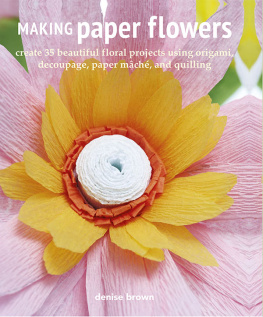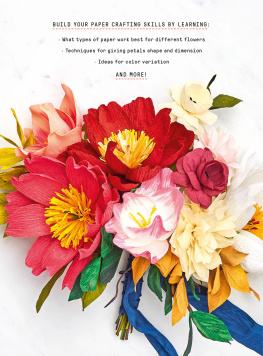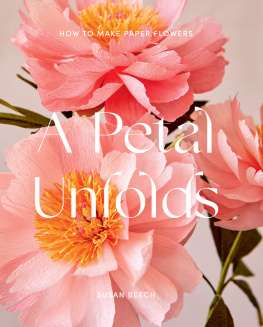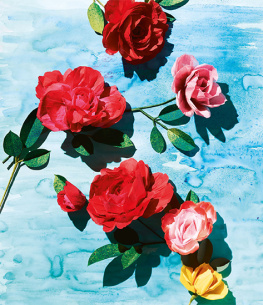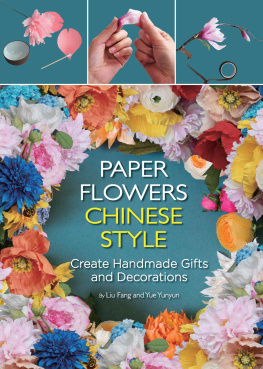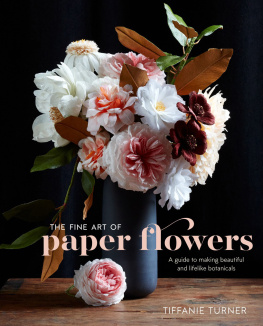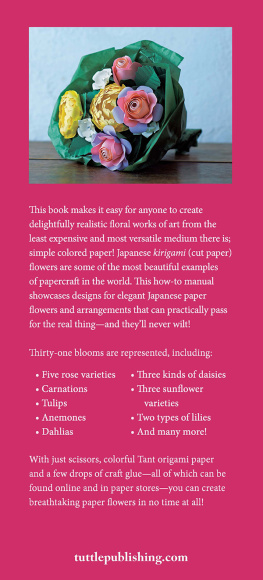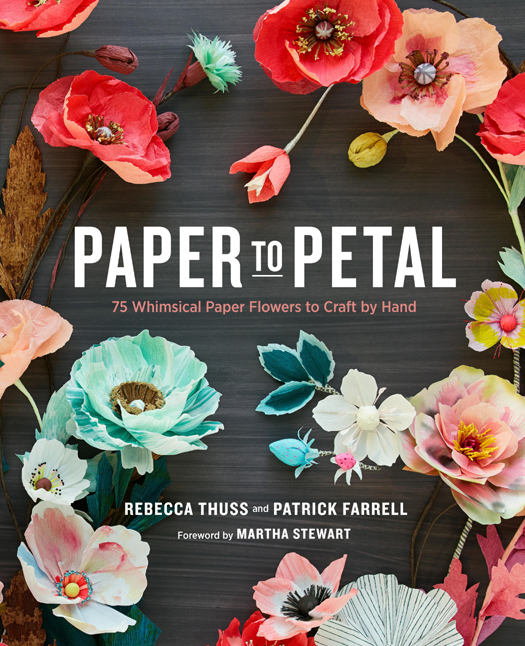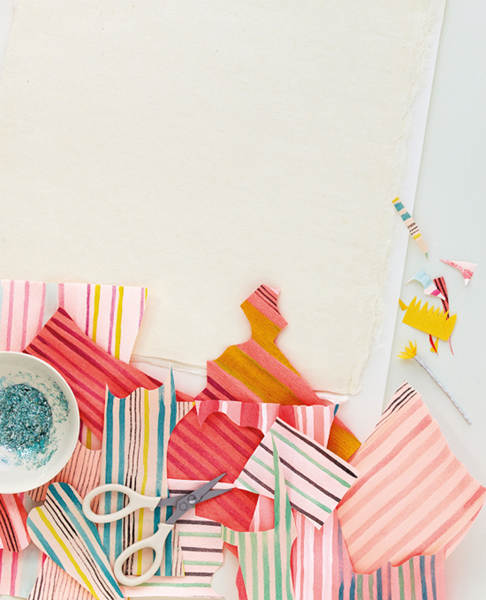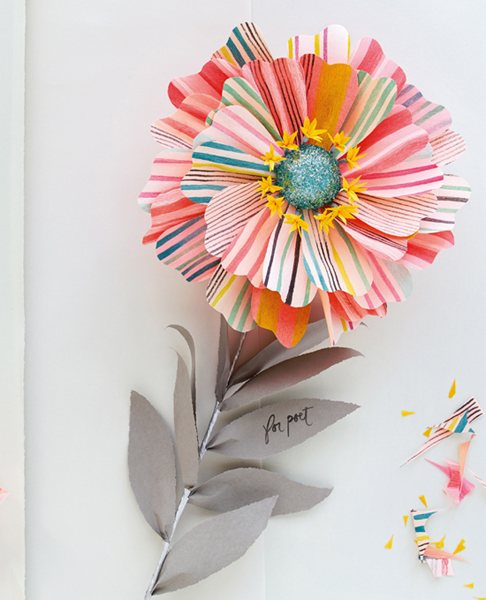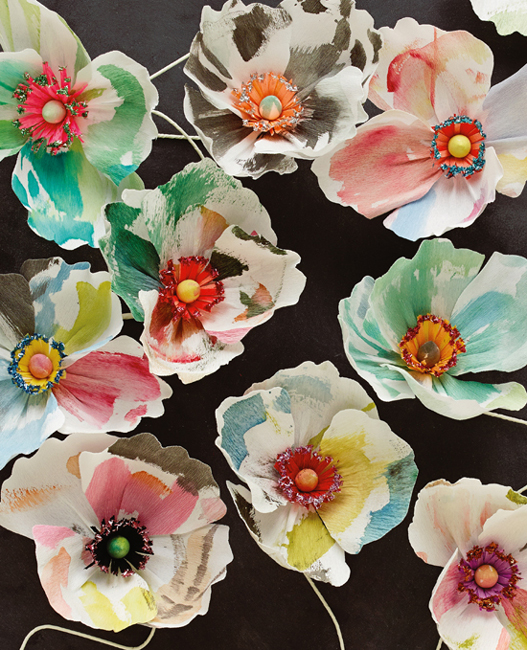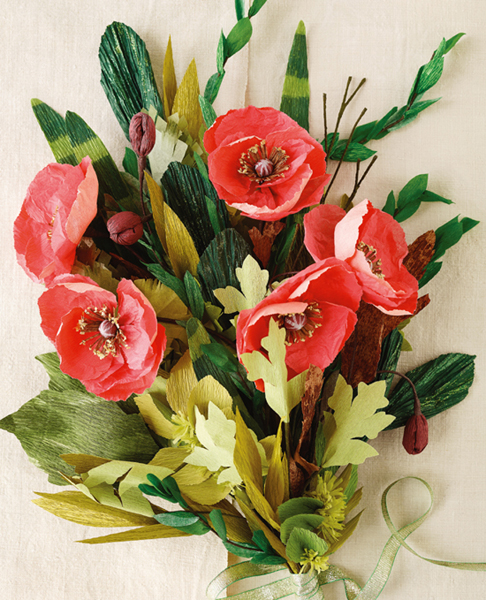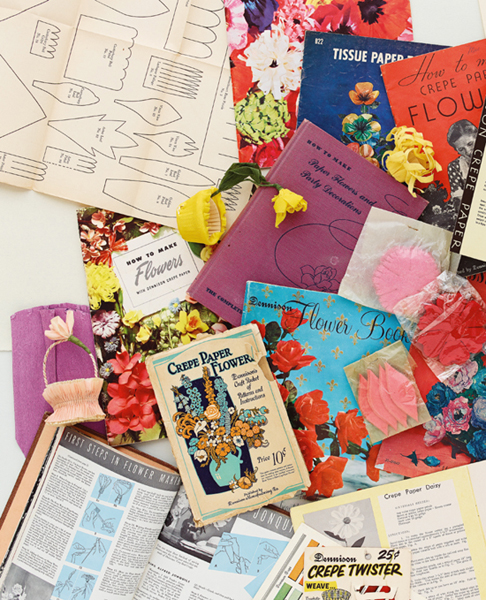MERRY-GO-ROUND : This 10" (25.5cm) bloom was made with apricot/light apricot double-sided crepe paper that was painted using different styles of striping paintbrushes. Fourteen Petals #220 make up the first layer of petals, and 17 Petals #218 make up the second layer. The center was made from a spun-cotton mushroom cap, covered in mixed aqua glitter and surrounded by individual florets made from Petal #264 in yellow double-sided crepe. Leaves #50 were cut using a deckle edger from gray decorative paper.
CUT-FROM-THE-GARDEN BOUQUET This lush bouquet is made with the coral poppies from project #75, Butterfly Nest, and assorted foliage from project #17, Multifarious Foliage. A handful of emerald green twisted paper ribbon leaves smeared with glitter glue were tucked in.
FOREWORD
I have been crafting for years and years, and I am always looking for old and new books that will enable me, with specific how-to instructions, to make something beautiful, prettily and perfectly. Paper to Petal is just such a book, a manual so carefully conceived, so beautifully illustrated and photographed, so innovative and creative, that it is impossible not to want to try each and every one of the 75 flower projects Rebecca Thuss and her husband, Patrick Farrell, have developed and photographed. This book is a labor of love as is so clearly evidenced by the whimsical combinations of colors and materials, by the referencing of old-fashioned manuals and workbooks, and by the modern interpretations and reimaginings of old-world techniques.
Paper flower making is several hundred years oldmy Polish ancestors fashioned peonies and roses from paper to embellish costumes and homes, and handed down those skills to their children and grandchildren. Young, early American women were taught to fashion flowers from paper, wax, and other materials as were young ladies in England and on the Continent. Paper flowers were crafted in Japan and China to embellish headdresses and beautify shrines and altars. Special papers were developed that permitted stretching and pulling and shaping, and wires and tapes were created to aid in the making of these blooms and foliage.
The authors have taken all they have learned and reimagined this craft in new and surprising waysnew types of papers have been introduced, paints and other materials employed, to change and enliven old techniques, and traditional flower forms have been thrown to the winds and new designs incorporated that are inspired by nature, by color, by materials, and by imagination.
I studied each and every page, happy to see a reinterpretation of nature, knowing that if she could, Mother Nature herself would want to evolve the poppy, all the foliage, and the hellebore and the lily and all other flowers to mimic what the authors have created.

History
Paper crafts and paper flowers have been a longtime tradition in many countries, including Mexico, Korea, Japan, and China. The variety of paper-art techniques developed over the centuriesorigami and kirigami in Japan and hanji/mulberry paper flower crafts in Koreais simply amazing. Often paper flowers were used as decorations in ceremonial events and celebrations, and as a social grouporiented folkcraft. Paper-flower crafting was also popular in the Victorian era and in the United States during the 1920s and 1930s, and then again during the mid-twentieth century. Flowers were created and used during times of the year when fresh flowers werent obtainable. When crepe paper became even more readily available, the range of instruction booklets expanded. These now vintage booklets are wonderful sources of inspiration.
INTRODUCTION
There is an intangible element in the handmade; an aspect of individuality that cant be duplicated. Its why my husband, Patrick, and I have crafted things by hand our entire lives. We have always been drawn to the beauty, charm, and personality of handmade items.
Paper flowers embody the best of these traits. Like real flowers, they are substantial yet delicate; impermanent yet artful. I have always loved vintage paper ephemera and adore the patina of aged paper. While in art school I began amassing what is now a large collection of vintage crepe paper, paper flowers, party nut cups, and old paper-flower instruction booklets. Over time Ive become ever more inspired by the art of making paper flowers and the history of this craft. I find myself continually making them to adorn packages and give them as gifts, for photography sets and projects, party and holiday decorations, and to simply enjoy at home. I learned basic skills from my vintage books and then developed my own techniques through years of experimentation. During my ten years as a style director at Martha Stewart Weddings magazine I had the opportunity to craft many paper-flower projects that were featured in editorial stories.
Most vintage paper-flower instruction books are rooted in creating forms found in nature. Real flowers provide an endless source of inspiration. The shapes, colors, textures, and variety are incredible and exciting to use as a starting point for paper crafts. Nature has perfected imperfection, and the same principle can be applied to paper flowers. No need to strive for perfection; each hand that makes a flower will introduce lovely differences that are beautiful. I love using nature as a reference, but I also enjoy creating whimsical flowers not found in the natural world. When designing flowers, Patrick and I can get inspired by pretty much anything, allow our imaginations to run wild, and create something unique, fanciful, and most important, fun to make.


